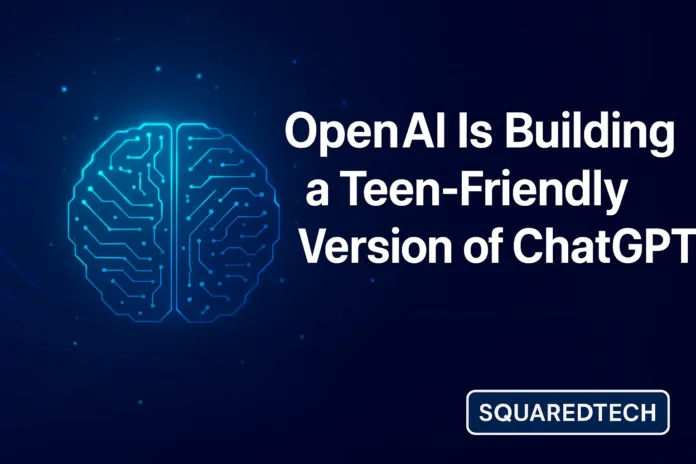Table of Contents
A New ChatGPT Experience for Teenagers
At Squaredtech, we closely track how artificial intelligence platforms reshape the way people learn, communicate, and seek help. OpenAI’s announcement of a teen-friendly version of ChatGPT marks a turning point in the ongoing debate over safety and responsibility in AI. The company revealed plans to introduce a “different ChatGPT experience” for teenagers, a move that responds directly to growing public concerns about how chatbots affect young people’s mental health.
The development follows a tragic lawsuit involving a family who argued that ChatGPT’s lack of safeguards contributed to the suicide of their teenage son. In light of this, OpenAI is building stronger protections to prevent young users from accessing harmful or unsafe interactions. The company emphasized that it is placing safety ahead of privacy and freedom for teens, with the aim of reducing risk while keeping the technology useful.
Read More About Our Article of ChatGPT Parental Controls: OpenAI’s Bold Move After Teen Safety Concerns Published on September 9th, 2025 SquaredTech
OpenAI CEO Sam Altman stated in a blog post that while ChatGPT is powerful, minors require significant protection. Altman explained that the new experience will include stricter restrictions compared to the standard version, and it will depend on age-prediction systems to separate under-18 users from adults. If ChatGPT cannot confidently determine someone’s age, the system will automatically default to the teen experience, ensuring added safety by design.
Features of ChatGPT’s Teen Mode
The teen version of ChatGPT will look familiar to users but will include built-in restrictions and oversight tools that focus on safety. OpenAI highlighted several important features:
1. Stricter Content Filters
The teen-friendly ChatGPT will block conversations that involve flirtation, sexual material, or discussions of self-harm, even in creative writing or role-play scenarios. These filters are designed to prevent teens from being exposed to harmful or triggering content, while still allowing them to use the chatbot for education, entertainment, and everyday communication.
2. Crisis Response Integration
One of the most significant changes is the system’s ability to respond to signals of emotional distress. If a teen expresses suicidal thoughts or other forms of crisis, ChatGPT may alert parents or, in emergency cases, contact authorities. This direct intervention shows that OpenAI is treating AI use among minors as a potential public health issue, not just a matter of technical design.
3. Parental Controls
Parents will gain new tools to monitor and manage their child’s interactions with ChatGPT. Features include linked accounts, custom rules about how ChatGPT responds, and blackout hours when the app becomes unavailable. These options give families a way to enforce boundaries and manage usage without entirely cutting off access to the technology.
We see these steps as an attempt to bridge the gap between innovation and accountability. The restrictions are not only about filtering harmful content but also about providing parents with practical control over a technology that teenagers often adopt faster than adults.
Why OpenAI Is Acting Now
The timing of OpenAI’s announcement is no coincidence. It came just hours before a Senate hearing in Washington, DC, where lawmakers are questioning tech companies about the risks AI poses to young people. Politicians and advocacy groups have expressed concern that AI chatbots can worsen mental health struggles or give harmful advice, particularly when dealing with impressionable teens.
Lawsuits and regulatory pressure have created a new sense of urgency. Much like Google’s decision to create YouTube Kids after facing criticism and government scrutiny, OpenAI is now moving to protect younger users before regulatory bodies impose stricter rules.
Altman’s blog post frames the effort as a balancing act between safety, privacy, and freedom. Adults, he argues, should retain broader freedoms and fewer restrictions. Teens, however, require added protections, even if that comes at the cost of reduced privacy, such as providing ID verification or stricter monitoring.
We recognize this as part of a wider trend in technology policy. Companies can no longer ignore the real risks that AI and social media present to younger audiences. Instead, they are being forced to redesign services in a way that explicitly considers the vulnerabilities of minors.
The Challenges Ahead
While OpenAI’s teen-focused ChatGPT represents progress, history shows that tech-savvy teenagers often find ways around restrictions. Whether by using VPNs, creating fake accounts, or borrowing access from adults, many minors manage to bypass age gates and safeguards. This reality raises an important question: will the new ChatGPT mode truly protect teens, or will it act more as a symbolic gesture?
For our readers, the key point is that AI safety measures are rarely perfect. Filters can block harmful content, but they can also frustrate users if they are too strict. Crisis alerts may save lives, but they also raise privacy concerns about how much data OpenAI should share with parents or authorities. Parental controls give families power, but they also risk driving teens to seek unmonitored alternatives.
The challenge is finding the middle ground between freedom and safety. OpenAI acknowledges that compromise is necessary, but whether this compromise works in practice will depend on how well the system resists misuse.
Broader Impact on AI and Society
The teen-friendly ChatGPT is more than just a product update. It signals how AI companies are being forced to adapt to social responsibility. What started as a research project has now grown into a technology used by millions worldwide, including children and teenagers. This shift makes safety a public issue rather than a technical detail.
For regulators, the case represents a test of corporate accountability. If OpenAI successfully implements protections that reduce harm without sacrificing utility, it may set a model for the AI industry. Other companies may follow, creating separate youth experiences for their own platforms.
For parents and educators, the launch could be a mixed blessing. On one hand, they gain more oversight and safety tools. On the other, they must now navigate a new digital environment where AI has become an everyday influence on how young people learn, socialize, and seek emotional support.
We believe this development highlights the urgent need for transparent AI governance. Without clear communication about how these safeguards work, families and teens alike may not trust the technology. Building confidence will require more than promises; it will require consistent results.
Looking Ahead
OpenAI says the teen-focused ChatGPT will roll out by the end of the year. The coming months will test how effective these protections are in real-life scenarios. Will the filters catch harmful conversations without breaking legitimate educational use? Will parental controls empower families, or will they drive teens to alternative platforms?
There is also the broader question of public trust. If OpenAI delivers a safer product that genuinely protects teenagers, it could strengthen the company’s reputation at a time when AI faces increasing skepticism. If the rollout fails, however, it could reinforce fears that AI firms move too fast and take responsibility too late.
From our editorial perspective, the teen-friendly ChatGPT is a step in the right direction, but it will only succeed if it proves both effective and trustworthy. Technology is advancing rapidly, but society’s expectations are clear: safety must come first for younger users, even if that means compromises on freedom and privacy
Final Thoughts
OpenAI’s teen-friendly ChatGPT is more than a new product feature. It reflects a cultural and regulatory shift in how AI is expected to interact with society. For teens, it promises stronger safeguards. For parents, it offers more control. For regulators, it demonstrates that companies are willing to respond to pressure before stricter laws force their hand.
At Squaredtech, we will continue to monitor how these changes unfold and whether they create meaningful protection for young users. The debate over AI, privacy, and mental health is only beginning, and the stakes could not be higher.
Stay Updated:Artificial Intelligence


